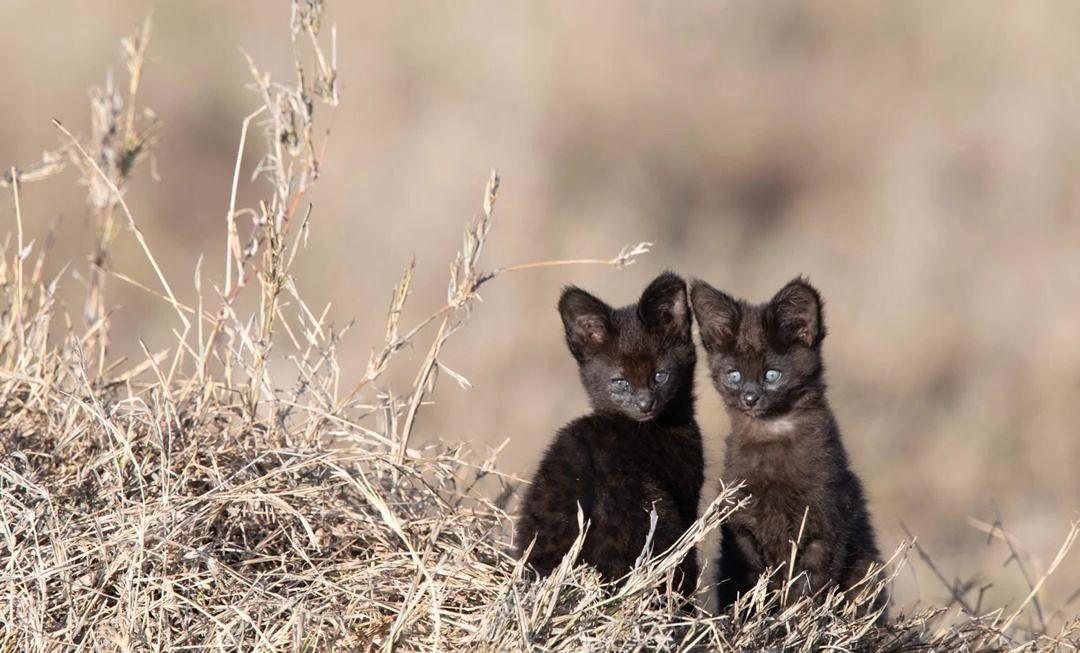<h1>Rare black serval cat pups appear in Africa</h1>
Not long ago, a tourist guide in Tanzania, Africa, was playing on the Nanoli Plain when he suddenly found two "little black cats" in the hay in the distance. Just when he was curious about where the two "little black cats" came from, a female serval cat appeared next to them, and the two "little black cats" immediately surrounded them, looking very intimate. After comparing the appearance of the "little black cat" and the female serval cat, the guide suddenly realized that the two "little black cats" were not ordinary domestic cats, but black serval cat cubs, and this adult female serval cat was the mother of the two little ones!

Pictured: A black serval cat cub spotted by a tour guide
Serval cats are small, wild cats found in sub-Saharan Africa, with their favorite habitats being savannas and wetlands, as well as at high altitudes. In appearance, the serval cat has three very obvious characteristics: the limbs are slender and long, the ears are high and round, and the coat color and spots resemble cheetahs. Although the two little ones have black hairs, they can still be distinguished by their towering ears and long limbs.
Female serval cats have a gestation period of about 74 days and usually lay 1 to 4 cubs in a litter. Mother serval cats usually give birth in dense vegetation or in burrows abandoned by animals such as aardvarks. Like domestic cats, serval kittens have their eyes closed at birth and do not open until they are about 10 days old. The pups are weaned at one month of age, and then the mother serval cat feeds them with a variety of small prey. At 6 months of age, the cubs begin to learn to hunt alone. At about 1 year old, the cub will leave her mother to live alone.
Pictured: Mother Serval cat and a litter of black cubs she gives birth to
It has been observed that the two black serval cat cubs are only more than a month old, and they obviously do not have the ability to hunt, and they have to rely on their mothers to hunt and support themselves. If nothing else, they can be found on the prairie for the next six months. However, it should be noted that the mother of the serval cat who is taking the cub is very vigilant, and once she perceives that it is not safe, she will move with the cub.
<h1>Why do serval cat mothers have different coat colors than their cubs? </h1>
This is not the first time a black serval cat has been found in the wild in Africa. Previously, some tourists, wildlife photographers and animal experts had taken several photographs of black serval cats in Africa. In 2019, wildlife photographer George Turner also photographed a black adult serval cat in the Nanoli Plain, this black serval cat has all black coats and its eyes look very bright, as if painted.
Pictured: Photographer George Turner photographs a serval cat
The appearance of black serval cats is related to genetic mutations - mutations in genes that control hair color cause a large amount of melanin to be produced in the individual, which makes the coat color black. Around the world, more than a dozen species of wild cats have appeared in black individuals, such as leopards, jaguars, slender-waisted cats, jungle cats, short-tailed cats, and so on. Compared to black leopards and black jaguars, black serval cats are rarer.
The black serval cat has a recessive mutation in the coat color mutation, and the offspring only show the trait of black hair when they receive a mutant gene from both parents. That is to say, the parents of these two black serval cat pups carry relevant mutant genes, their mother is a normal phenotype but carries a serval cat with a mutated gene, and their father must also carry a mutant gene, but it is difficult to say that it is not a black serval cat.
Pictured: A photographer photographing an interaction between a common serval cat and a black serval cat in Kenya
<h1>Where do black serval cats often appear? </h1>
According to zoologists, the black serval cat is currently mainly found in East Africa, especially in highland areas above 2000 meters above sea level (such as Kilimanjaro at an altitude of 3800 meters). But this time, the two black serval cat cubs appeared at an altitude of only about 1,000 meters. Therefore, animal experts speculate that it is likely that the serval cat carrying the relevant mutant gene came from the high altitude to the low altitude and passed the gene to the offspring of the low altitude area, which is the so-called gene spread.
Pictured: Ordinary serval cat pups
<h1>Is black hair good for the survival of serval cats? </h1>
Cats have evolved to this day, and their various characteristics must have had their own special uses. For serval cats, the reason why their coat color is what we often look like today is that the coat color is yellow or light yellow, covered with black spots, because it is a protective color that can blend with the surrounding grass environment, which is easy to avoid predators and is conducive to catching prey.
Therefore, zoologists believe that the "non-mainstream coat color" of black hair will bring inconvenience to the hiding of serval cats, especially during the day, and they will be very conspicuous in the grass.
Pictured: During the day, the black serval cat is very conspicuous
However, since this trait can be inherited, it means that it will give individuals some survival advantages. Zoologists speculate that the temperature is lower at high altitudes, and the hair of the black serval cat will bring a unique advantage: it is conducive to absorbing light energy, conserving heat, and thus better resisting the cold. This may be the reason why black serval cats are mostly found at high altitudes.